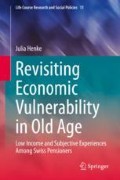Abstract
Missing values are an inevitable problem with survey data. Ignoring them can yield distorted results if values are not missing at random or if comparisons are based on samples of varying size. Previous research on the VLV survey suggests that the economically vulnerable population has been successfully captured within the sample population as the recorded poverty rates are equivalent to those reported in other studies as well as in official statistics. Still, it was important to investigate the pattern of non-responses, in particular for the variables income and wealth, in order to assess any potential biases. In our treatment of missing values, we proceeded as follows: First, we attempted to fill-in missing data in cases where we had sufficient knowledge about other items that were related to the mission questionnaire item. Basically only psychometric scale qualified for this method (pro-rating). Second, we assessed the pattern of missing values of those variables that had a considerable amount of missing values in order to detect whether they were missing in a non-random manner.
Access this chapter
Tax calculation will be finalised at checkout
Purchases are for personal use only
Notes
- 1.
- 2.
All other variables had less than 3.3% missing values.
- 3.
This means that the data sets contained no missing values among all covariates used for regression analysis on outcome variables MV perc_ev, MV obj_ev and MV wealth.
References
Budowski, M., Tillmann, R., & Bergman, M. M. (2002). Poverty, stratification, and gender in Switzerland. Schweizerische Zeitschrift Für Soziologie, 28(2), 297–318.
Gabriel, R., & Oris, M. (2013). Poverty and inequality amongst the elderly population in Switzerland, 1979–2011. Bern, Switzerland.
Heckman, J. J. (1977). Sample selection bias as a specification error (with an application to the estimation of labor supply functions) (Working Paper No. 172). National Bureau of Economic Research. Abgerufen von.
Long, J. S. (2006). Regression models for categorical dependent variables using stata (2nd ed.). College Station: Stata Press.
Oris, M., & Nicolet, M. (2016). Mesures et capture de la vulnérabilité dans une enquête sur les conditions de vie et de santé des personnes âgées. L’expérience de VLV (Vivre-Leben-Vivere) en Suisse. In Oris, Michel & Cordazzo, Philippe & Bellis, Gil & Brown, Elizabeth & Parant, Alain. Les populations vulnérables. Actes du XVIe colloque national de démographie (207–224). Aix-en-Provence - 28-31 mai 2013 - Bordeaux: CUDEP (Conférence Universitaire de Démographie et d’Étude des Populations).
Polit, D. F., & Beck, C. T. (2011). Nursing research: Generating and assessing evidence for nursing practice (Auflage: Ninthtion.). Philadelphia: Lippincott Raven.
Rising, B. (2010). Multiple imputation. Stata Corp LP. Abgerufen von.
Rubin, D. B. (1976). Inference and missing data. Biometrika, 63(3), 581–592.
Schafer, J. L., & Graham, J. W. (2002). Missing data: Our view of the state of the art. Psychological Methods, 7(2), 147–177.
StataCorp. (2013). Stata 13 structural equation modeling reference manual. College Station: Stata Press.
Author information
Authors and Affiliations
Appendix
Appendix
Rights and permissions
Copyright information
© 2020 Springer Nature Switzerland AG
About this chapter
Cite this chapter
Henke, J. (2020). Missing Values. In: Revisiting Economic Vulnerability in Old Age. Life Course Research and Social Policies, vol 11. Springer, Cham. https://doi.org/10.1007/978-3-030-36323-9_10
Download citation
DOI: https://doi.org/10.1007/978-3-030-36323-9_10
Published:
Publisher Name: Springer, Cham
Print ISBN: 978-3-030-36322-2
Online ISBN: 978-3-030-36323-9
eBook Packages: Economics and FinanceEconomics and Finance (R0)

